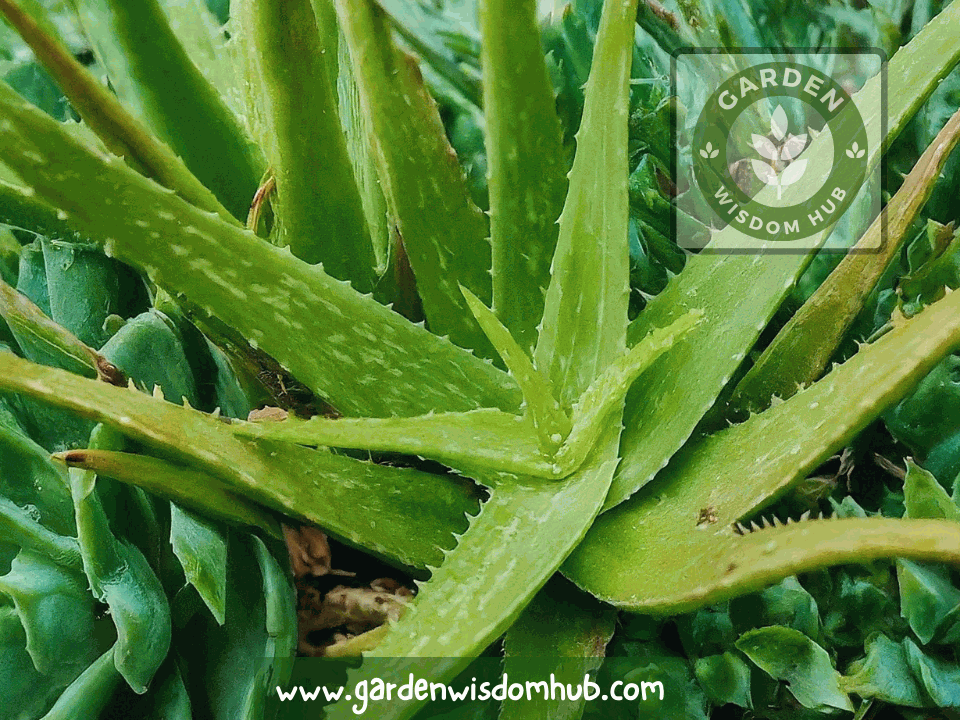Indoor Aloe Vera plants: a clump of greens that could be its long-lost relatives.
Haworthia:
Its little succulent plants resemble aloe vera’s long-lost twins. They have thick, pointy leaves like porcupine quills in a tidy rosette design. Indoor houseplants like Haworthia are party animals. They’re rare, like a unicorn in sunglasses, and lazy like a sloth on Sunday. No wonder they’re popular! Like sun-seeking detectives, these plants crave bright, indirect light. To avoid becoming caught in moist soil, they require well-drained soil like thirsty travelers. Haworthia plants’ green leafy capes combat airborne pollutants like superheroes.
Gasteria:
Now, there’s a succulent plant species that could be Aloe vera’s twin! These plants are like stand-up comedians with thick, meaty leaves that are rollercoaster-like. They include patterns and textures that will inflate your eyes! Gasteria plants are fun indoor plants. With their eye-catching ornaments, they’re party favorites. These plants require care like aloe vera’s distant relatives. They love bright, indirect sunlight and well-draining soil. Gasteria plants rule low light and thrive easily.
Bergeranthus:
These small guys look like South African aloe vera. These succulents are from Africa. These plants are plant superheroes with thick, meaty leaves that can store water. They’re drought-resistant, making them ideal for forgetful plant owners who forget to water. Their indoor success is like having your retreat in your living room. Bergeranthus plants are party animals, adding color and character without much maintenance. Similar to sunbathers, these plants prefer bright but indirect sunshine. Like a well-prepared host, they like well-draining soil to avoid damp roots. Want a cucumber-cool plant? Look no further! Why not try a unicorn-like plant instead of Aloe Vera? There are many options to make your yard sparkle like fireworks! Put on your thinking gear, and let’s investigate plant options that will make your neighbors green with envy!
What Is an Alternative Plant for Aloe Vera?
You can check these following points:
Agave:
Like aloe vera’s wacky siblings, agave plants are constantly ready to change things up. Water-storing leaves like a camel’s hump make these plants desert superheroes. These sturdy guys can endure even the driest conditions. Agave plants are plant supermodels with their gorgeous appearance and remarkable structure. Like celebrities avoiding paparazzi, these plants worship the sun yet prefer shade. Like a well-trained athlete, they need fast-draining soil. Agave plants are kitchen tools like Swiss Army knives and have more uses than chameleon’s colors. This indoor plant mimics Aloe Vera! A green-thumbed doppelganger. As alike as two peas in a pod, you won’t be able to distinguish them. This beauty of a plant should be brought home!
Indoor Plant That Looks Like Aloe Vera:
You can check these plants:
Yucca:
Yucca leaves resemble swords, like aloe vera’s long-lost cousins. These plants are popular indoors because they seem deadly and take less care than a bowl of goldfish. Yucca plants are plant superheroes that can easily survive drought. They can change hues like chameleons to fit any indoor atmosphere. Like celebrities avoiding paparazzi, these plants worship the sun yet prefer shade. Like a well-prepared athlete, they need soil that drains faster than a cheetah fleeing a lion. Yucca plants are plant superheroes that clean the air. That outside plant that looks like Aloe Vera—what is it? Almost the same, but with a twist! It seems Mother Nature created a copy of our favorite Aloe Vera as a hoax. Imagine walking through your garden when you see this plant that looks like Aloe Vera’s long-lost cousin. Same prickly leaves, vivid green
Outdoor Plant That Looks Like Aloe Vera:
You can read these following points.
Maguey:
Cheeky succulents like maguey are aloe vera’s long-lost relatives. These plants are plant superheroes with large, thick leaves that store water. They flourish in the harshest droughts. Tough as nails! With its striking appearance and architectural flare, maguey plants are landscaping party favorites. These plants worship the sun—they can’t get enough! Like a proper drainage system, they like bone-dry soil. Give them lots of sunlight and water-flowing soil! Maguey plants are considered a treasure mine of culinary and therapeutic benefits. Aloe Vera-like plants: These little cacti grow as slowly as a snail on a Sunday walk. Like aloe vera’s distant cousins, they have their own style. As juicy as a steak, these bad guys with washboard-ribbed stems. Remember those prickly tubercles that look like water-filled containers? What a drought-ready plant!
Plants Similar to Aloe Vera:
Following plants are similar to Aloevera:
Ariocarpus:
Ariocarpus plants liven up dusty North American deserts. Like sunbathers who like shade, these plants flourish in bright, indirect sunshine. Happy roots need well-draining soil, like a good chef. Desert warrior Ariocarpus plants are tough as nails and can resist drought. Due to their little upkeep, you can leave them alone, and they’ll thrive.
Twisted Bromeliads:
They’re like aloe vera’s long-lost cousins but dryland-adapted. With their rosette-like leaves, these plants are strong as nails and ideal for arid spaces. Landscapers love dry bromeliads because they’re unusual and require less care than a lazy sloth on Sunday afternoon. These plants are like sun-loving divas who enjoy indirect sunlight and goose-loose soil. Dryland bromeliads clean the air like superheroes. This plant is prickly like a porcupine and cunning like a fox! It may look like your neighborhood aloe, but don’t be deceived. With spikes like a medieval knight’s armor, this plant means business. As a cactus on steroids, it can defend itself from unwary passersby. Consider adding this spiky beauty to your collection, but be prepared to handle it.
Plant That Looks Like Aloe With Spikes:
Pineapple Plant:
The pineapple plant, especially its immature sprout, resembles aloe vera. These sword-sharp leaves grow in a rosette arrangement like a well-organized army. Pineapple trees are popular for their tasty fruit and attractive appearance. Like sun worshipers, these plants can’t get enough sunlight! They like bone-dry earth. Give them lots of sunshine and dirt that won’t saturate them! Pineapple plants are a tasty and healthy resource.
Conclusion:
Gardeners are like children in a candy store when it comes to aloe vera-type plants, which come in many varieties for indoor and outdoor use. The sleek, pointed leaves of Haworthia and the rugged, meaty appearance of Agave make these plants like aloe vera’s fashionable cousins. They look cool and offer similar benefits. Is a plant as easy to care for as a pet rock or as drought-resistant as nails?
Look no further! The variety of these options will meet all your gardening needs. In a nutshell, the plants that resemble aloe vera offer a diverse array of options for both indoor and outdoor gardening enthusiasts. From the elegant leaves of Haworthia to the rugged beauty of Agave, these plants not only mimic the aesthetic appeal of aloe vera but also provide similar benefits. Whether you are seeking a low-maintenance indoor plant or a resilient outdoor specimen, these alternatives cater to a wide range of gardening needs. With their unique features and health benefits, these plants are a valuable addition to any garden or home.
Watch This YouTube Video For More Guide Related to: Plants that Look like Aloe Vera
FAQs:
Are plants that look like aloe vera safe to have indoors?
Can aloe vera-like plants be kept indoors? I guarantee that most aloe vera-looking indoor plants are as safe as a kitten in a basket. Before bringing plants into your home, research their care demands and toxicity. Surprises are especially bad if you have pets or children!
Do plants that look like aloe vera have similar health benefits?
Do aloe vera-like plants provide the same health benefits? Like aloe vera’s long-lost cousins, Agave and Gasteria exist. These nasty boys have substantial health advantages and are utilized in traditional medicine for many diseases. Before making a strange herbal combination, consult a doctor.
Can I grow plants that look like aloe vera in my garden?
You’ll be shocked! Many plants resemble aloe vera’s long-lost relatives. Consider Yucca and Maguey. In dry, desert-like gardens, these bad boys thrive like they were designed for each other! These plants are party favorites, often making jokes and people laugh. Their flamboyant beauty and ability to withstand harsh environments make them the plant world’s Beyoncé.
Are plants that look like aloe vera easy to care for?
Yes, many plants are as easy to care for as a stroll in the park. Beginner gardeners and busy people will love them—aloe vera’s long-lost cousins. Like a lazy cat, these plants require little care and can survive in more light than a disco chameleon.
Can I use plants that look like aloe vera for landscaping?
You wouldn’t believe it! Aloe vera-like plants include Dryland Bromeliads and Ariocarpus. They can truly improve your landscaping! With their quirky looks and desert-survival skills, these plants are party favorites.
To learn more about Houseplants check out my guides:
Signs of an Underwatered Aloe Vera Plant
Aloe Plant Overwatered: Signs and Step-by-Step Solutions
How to Revive and Save an Aloe Plant
How Much Water Do Sunflowers Need?
James Porter
Welcome to our haven of gardening and plant care, where outdoor and indoor planting enthusiasts come together! At Gardening Wisdom Hub, we aim to provide you with the most authentic information on anything related to gardening, plant care, seasonal planting etc.
The author of our website is James Porter, an experienced industry veteran. He has a deep interest in everything green. James’s enthusiasm for exploring plants’ features and learning new gardening methods began at a young age. Gradually, his passion increased with time, leading him to become a highly esteemed professional. His extensive knowledge makes him a priceless resource for inexperienced and seasoned gardeners.


